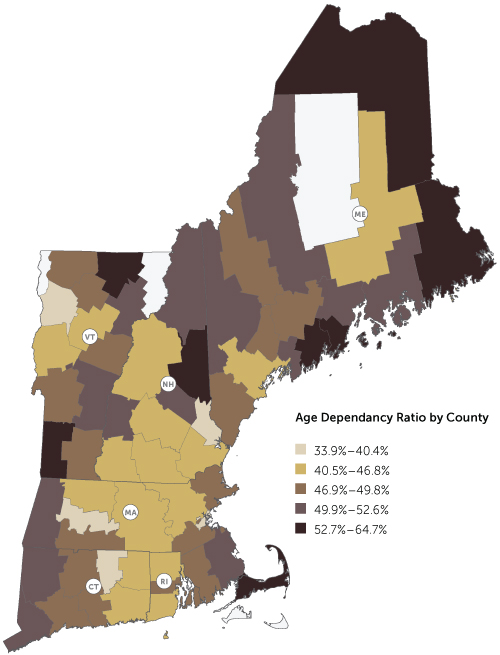Mapping New England: Pressure on the Working-Age Population 
Comparing the working-age population with the number of children and the population 65 years and over yields what is called a dependency ratio. The dependency ratio measures the pressure on the productive population to support the population that is not in the labor force.
In New England, for every 100 working-age individuals, there are 47 people who are either 65 and older or under 15 years old. Maine's high dependency ratio is mainly driven by the large percentage of the population that is 65 years and older. Maine's dependency ratio for old age alone (25 percent) is four percentage points higher than New England's (21 percent). Suffolk County, Massachusetts, has the lowest dependency ratio (34 percent) for over 65 years and under 15 years. Barnstable County, also in Massachusetts, has the highest ratio (65 percent).

Source: American Community Survey
2010-2012 three-year estimates.
Dependency ratio: (number of people under 15 + number of people 65 years and older) / number of people aged 15-64.
Old-age dependency ratio: number of people 65 years and older / number of people aged 15-64.
Articles may be reprinted if Communities & Banking and the author are credited and the following disclaimer is used: "The views expressed are not necessarily those of the Federal Reserve Bank of Boston or the Federal Reserve System. Information about organizations and upcoming events is strictly informational and not an endorsement."

 About the Authors
About the Authors
Ana Patricia Muñoz

 Resources
Resources
Related Content
Mapping New England
Research Forum: Assessing the Impact of New England's Changing Demographics
The Criminal Population in New England: Records, Convictions, and Barriers to Employment
Smart Places, Getting Smarter: Facts about the Young Professional Population in New England States



